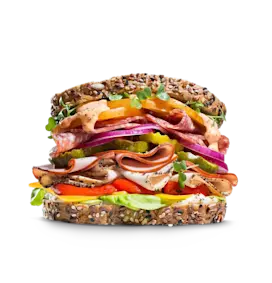Featured in this post
Why Digital Transformation in the Food Industry Is Imperative and Urgent
Why Digital Transformation in the Food Industry Is Imperative and Urgent
15 Mar 2024
Jack Payne
It may sound cliché, but the food and beverage industry really is constantly changing and unendingly complex.
On one hand, evolving consumer preferences—whether that's the rise of plant-based and health-first foods, or demands for traceability and sustainability—mean it's vital for your business to ensure relevant and good quality products are available exactly when your customers want them.
On the other hand, a range of factors make that objective more complicated than ever. Government regulations have become stricter to better protect public health and ensure total compliance. The food supply chain faces increased disruptions, putting your agility and resiliency to the the test. Plus, rising costs and talent shortages are increasing the pressure on your operation to maximize efficiency and productivity.
All of these considerations make simply conducting your day-to-day operations that much more complex. But with the rate of change likely to increase going forward as our societies become more connected and technologically advanced, your organization must “get with the times” or be left behind.
So, how can you best prepare your company for the future?
Digital transformation is the answer. Or more specifically, using modern cross-functional cloud software solutions, and leveraging advances in technology such as artificial intelligence (AI) in food manufacturing, to drive transformative change across your food and beverage business.
Read on to learn why digital transformation in the food industry is so critically important for long-term success and why now is the time to jumpstart the process at your business.
Why Is Digital Transformation Critical for Success in the Food Industry?
As we're sure you know, the buzz about digital transformation has been around for a while now, and it's unlikely to be going anywhere soon. That's because, with a solid digital transformation strategy, businesses like yours can unlock a range of valuable benefits—ultimately boosting profitability and ensuring long-term success.
These benefits include more holistic improvements, like better visibility of important information and enhanced interdepartmental collaboration, as well as the following key operational advantages.
More Accurate and Immediate Data Collection
The core principle of digital transformation is to replace outdated and analog processes with modern, fully integrated technology. Doing so immediately reduces or eliminates the inaccuracies, delays and lost data associated with manual processes.
For example, many organizations choose to implement a food industry-specific enterprise resource planning (ERP) system as the foundational "single source of truth" for their digital transformation. ERP platforms designed for food and beverage companies can integrate with smart sensors, scales, meters and thermometers to automatically conduct the readings that help you monitor product quality and process efficiency. Better still, the process isn’t subject to the imperfections of manual record-keeping—human error is removed from the equation, so bad handwriting or a slip of memory won’t spoil the integrity of your data.
What’s more, these integrations also speed up the process to a remarkable degree, importing the results to your central database in real time so that you can act based on the most up-to-date facts and figures. That level of agility and assuredness is what you need for the dynamic food and beverage marketplace.
Safer Products and Procedures
With the pandemic still fresh in our memories and allergen management concerns ever-present, health and safety is top-of-mind, with both shoppers and regulatory agencies having uncompromisingly high standards for product safety. At the same time, food and beverage facilities are busy and potentially hazardous workplaces if the right measures aren’t in place to protect your staff.
Luckily, choosing the right solutions on your digital transformation journey can help you streamline and automate food safety procedures—giving you peace of mind and watertight compliance while simultaneously increasing the efficiency of your operations.
Selecting a food ERP as the basis for your digital transformation will unlock features such as expiration management tools, automated compliance checks and end-to-end-traceability functions that facilitate the isolation of contaminations and speed up the recall process. All of these will help ensure that everything coming off your lines is completely fit for consumption.
An advanced system like Aptean Food & Beverage ERP can also help keep your personnel safe with alerts for dangerous deviations in processes and automatically scheduled safety audits.
Greater Efficiency and Profitability
We’ve already pointed out how vital good data is for decision-making, and that is taken a step further when you select digital transformation technologies that include analytical tools or strategic planning functionalities. These features allow you to look critically at your operations and identify opportunities for improvement—helping maintain a healthy bottom line and fueling future growth.
By looking at the efficiency and profitability results that a purpose-built food ERP system can collect, you’ll be able to identify issues in your current processes that are holding you back from peak performance. These platforms also make financial data easily accessible and highly visible, informing your decisions about which product lines to focus on and which might be best scrapped.
Meanwhile, an overall equipment effectiveness (OEE) solution can help you determine what’s holding you back from optimal operation—whether it’s excess waste in production, equipment malfunctions or a fundamental flaw in your procedures—so it can be rectified. Or, if you’re running your own transportation fleet, advanced route optimization software enables you to not only improve the efficiency of your day-to-day delivery operations, but also model “what-if” scenarios to ensure you’re always making the most profitable decisions.
For example, you could easily model the impact of moving your warehouse to a new location or supplying a new customer outside of your usual geographic range. With this functionality, you’re able to accurately calculate cost-to-serve for new customers and thoroughly test ideas for growth before implementation—helping you drive the most revenue and profit.
With so much data available from all of these systems, the best digital transformation strategies also include implementing business intelligence (BI) software to ensure key metrics can be easily mined for actionable insights—putting efficiency and profitably at the heart of your continuous improvement cycle.
Why Is Now the Time to Accelerate Your Digital Transformation?
Having the right technology on your side is the best way to prepare for the future and stay ahead of the curve as further changes occur in the food and beverage world. Plus, you’ll need to be fully equipped to get the edge on the competition as the industry continues its steady growth.
Of course, digital transformation in the food industry is not a overnight revolution, but that makes getting started now all the more crucial. Let's dive in to the top motivations for stepping up your modernization efforts as soon as possible.
Becoming More Resilient to Disruptions
Whether it's transportation delays, worker shortages, demand volatility, natural disasters or geopolitical conflict, your food and beverage business must be ready to deal with whatever curveballs the food supply chain throws. After all, if you can't get necessary materials, produce your products or fulfill orders on time, you risk disgruntled customers turning to your competitors.
Using a food ERP platform as the foundation of your digital transformation strategy helps mitigate these challenges, with fully configurable supply chain management features for streamlined pivots in times of transition and process automations to make up for employee unavailability. What’s more, deploying your solution via the cloud provides even greater flexibility, and demand forecasting tools serve to create a firm understanding of what to expect in the seasons to come. This effort in particular can be bolstered by choosing an ERP system that's underpinned by AI innovation to streamline and improve sales and inventory forecasts based on your historical data.
Another powerful technology that can help your business mitigate disruptions is enterprise asset management (EAM) software. These systems are dedicated to your equipment and its maintenance, allowing users to place and monitor work orders and manage inventory of spare parts that may be needed in repairs.
Keeping Up With the Pace of the Market
Seizing upon openings in the market and developing new offerings in line with current consumer trends are great ways to get a leg up on other brands in your segment. In order to move quickly on these opportunities, though, you need the right tools at hand.
The features of food industry ERP software have you covered here too. The robust demand analytics that these systems provide let you keep an eye on developing shifts in preferences, while the recipe and formula management features empower your research and development (R&D) teams to run with a novel idea that will delight and excite customers.
In addition, implementing a specialized product lifecycle management (PLM) system as part of your digital transformation journey can help drive innovation, streamline R&D and new product development processes, and accelerate time to market.
Taking Advantage of the Latest Technology
AI, the Internet of Things (IoT), blockchain and cloud software are just a few of the advancements that are starting to impact the food and beverage industry. In the future, robotics, autonomous vehicles, satellite imaging and other developments will become more prominent, with more businesses incorporating them into their facilities and operations.
This not only means that you cannot delay your digital transformation—because your competitors are going to be leveraging these advancements to leave you in the dust—but also increases the importance of choosing systems and vendors that prioritize innovation. In particular, you may want to look for:
Cloud Deployment: As opposed to on-premise options, cloud software has rapidly become a pillar of successful digital transformations due to the improved scalability, enhanced security and additional agility it offers. So be sure to look for a vendor with a cloud-first approach and proven experience implementing cloud systems for businesses like yours.
AI-Driven Capabilities: We're all aware of the boom in AI technology thanks to consumer-focused news stories, but don't overlook the transformative power that adopting AI capabilities can have for your business. Choosing a vendor that's committed to delivering cutting-edge solutions by embedding AI tools will be critical for future-proof success. In particular, look for capabilities that improve predictive maintenance, demand forecasting and data quality to help you save time and prioritize productivity.
Pre-Existing Integrations: Getting software systems in place that offer established integrations with existing and emergent technologies is crucial if you want to streamline your digital transformation. Whether that's integrating your food software ecosystem so your teams are always in sync, or creating an IoT network of smart devices to automate data capture and optimize processes across your entire food supply chain.
Finding a Digital Transformation Partner You Can Trust
Want one final reason to gear up your digital transformation strategy? By conducting your due diligence and finding a solution provider that knows food and beverage inside-out, your organization can gain a valuable ally. Not only can this partner help guide the implementation of your selected technologies, but they can also offer ongoing support down the road.
Here at Aptean, we’re proud to offer best-in-class business systems that allow our clients to overcome their toughest challenges. From the core food ERP software to our full suite of complementary solutions—including OEE, EAM, Routing & Scheduling, Business Intelligence and more—we have your entire digital transformation roadmap covered.
Aptean’s food ERP is packed with features to transform any food and beverage business, like robust financial and quality management tools, as well as sector-specific functions to help specialized businesses account for catch weight, allergens, consignment tracking and more.
What's more, our ERP for the food industry embeds cutting-edge AI tools to ensure that your business is able to lead with innovation and drive your industry forward. And, because it's built on Microsoft Dynamics Business Central 365, not only do your teams benefit from a familiar and proven framework, but you can also leverage a range of Copilot and Azure AI capabilities to enhance customer satisfaction and drive productivity.
The icing on the cake? When your company selects one of our offerings, you can count on our experienced teams’ advice and expertise throughout deployment, from creating a roadmap and timeline to troubleshooting and rolling out extra modules you may need. We also offer the sort of flexible cloud-based deployments described above, and with dedicated IT teams and redundant offsite servers, we can boast system uptime of 99.9% or better.
With that kind of stability, you’ll be on much firmer footing facing any new surprises that the years to come have in store.
Ready to kick off your digital transformation in the food industry? Read about our Digital Transformation benchmark quiz; contact us today or request a personalized demo.
Aptean Food & Beverage ERP Customer Success Stories
These 10 clients from across various food and beverage sectors achieved more with our solution.



